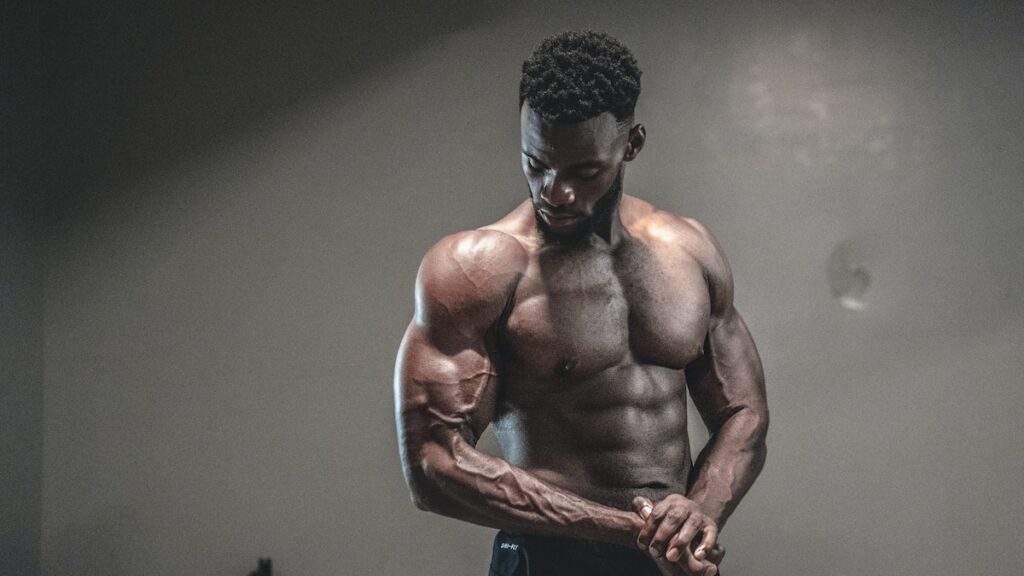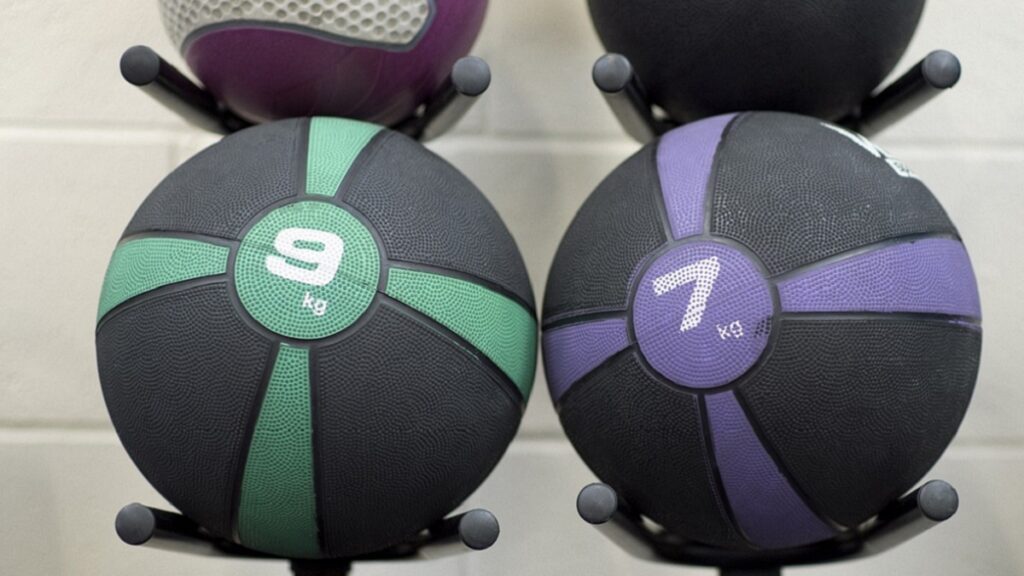The Landmine and Overhead presses are essential for fantastic upper-body structure. Typically, the two are popular for shoulder health development and fast muscle building. However, these presses differ in various aspects, such as target muscles, equipment, and performance. Landmine Press vs. Overhead Press: What are their differences?
The main difference between Landmine Press and Overhead Press is the execution angle. Landmine requires pressing up and slightly forward, while its Overhead counterpart demands a straight-up posture. Also, the weight isn’t under your control with Landmine, reducing the load on your joints.
This article provides an in-depth review of Landmine Press and Overhead Press, mainly focusing on how to do them, their benefits, variations, alternatives, and more. We aim to help you pick your ideal option with ease.
Let’s get started!
Landmine Press Vs. Overhead Press: What Makes Them Different?
The performance angle is the leading cause of the difference between the Landmine Press and the Overhead Press. Landmine Press is a press-up-slightly-forward exercise that relieves the weight control burden due to the barbell attachment to the landmine. On the other hand, Overhead Press is a straight-up pressing movement.
Additionally, Landmine Press boosts your shoulders’ overall health and enhances chest improvements. The workout has various variations that combine with other body parts, such as hips and thighs, among others. Conversely, the Overhead Press works a more comprehensive range of muscles, including shoulders (deltoids), upper back, chest (pectoral), and triceps.
Besides the ‘standing’ position, you can have a ‘kneeling’ or a ‘half-kneeling’ Landmine Press performance position. The kneeling posture is beginner-friendly as it takes the weight off your back/spine, while the Overhead approach exerts the weight on these body parts. The half-knee one protects your lower back, which arches in the case of the Overhead Press.
Landmine Presses are more complex than Overhead Presses. Thus, the latter can be a foundational exercise for other workouts such as the Thrusters, Push Press, Curl, and more.
For a better understanding of Landmine Press vs. Overhead Press, we look at each exercise in detail. Read on.
What Is Landmine Press?
The Landmine Press is a weight-raising workout involving lifting one end of a barbell while the other has a piece of equipment attachment. The equipment keeps the weight in place during the exercise. The typical Landmine requires you to raise the barbell from chest level.
The presses have become progressively popular among general gym goers and strength athletes. They offer a remarkable motion range, maintain unilateral strength, and it’s friendly to joints.
When it comes to Landmine Press vs. Overhead Press, Landmine requires more stability, permits scapular movement, and uses less weight.
Which Are the Needed Equipment for Landmine Press?
There are 3 needed equipment for the Landmine Press, as outlined below:
- Landmine Attachment
- Weight Plates
- Barbell
Which Muscles Does Landmine Press Work?
Shoulders, chest, and core muscles are the target of Landmine Press. Below are the muscles that the exercise works:
- Scapular Stabilizers
- Upper Back Muscles
- Pectoralis
- Trapezius
- Deltoids
- Triceps
- Glutes
- Abs
How Do You Perform Your Landmine Press Workout?
Landmine Press performance can be classified into set up, press up, and descend. Below are the workout’s execution steps:
- Step 1: Put the barbell’s one end into the landmine base or a wall corner, placing a plate (25 or 45 pounds) on the sleeve’s top. (Ensure there’s a towel between the wall and the bar to prevent wall scuffing).
- Step 2: Use weight plates to load the second end of the barbell.
- Step 3: Face the barbell’s weighted end while standing and keep your feet shoulder-width separate, with knees slightly bent and core braced.
- Step 4: Bend and grab the barbell’s end with both hands and start at chest height.
- Step 5: Move the barbell to the front side of your left shoulder, remove your right hand, and press the bar full length with your left hand.
- Step 6: Put your hand straight up so the elbow is directly below your hand, and keep the torso upright and wrist straight. Shake a bit, moving your left foot slightly back.
- Step 7: Lower the bar to the starting point under control.
- Step 8: Repeat until you complete all reps and move to the other arm.
What Are the Landmine Press Sets and Reps?
Below are the Landmine Press Sets and Reps depending on the workout’s objective:
- Muscle growth: 3-5 sets of 6-10 repetitions or 2-4 sets of 12-15 reps. Have an interset break of 45-90 seconds.
- Muscle strength: 3-5 sets of 3-5 repetitions with heavy loading. Have the required rest between sets.
- Endurance: 2-4 sets of 12-20 repetitions (light-moderate load).
What Are the Common Landmine Press Mistakes?
The common Landmine Press mistakes include the following:
- Wrong hand position
- Inaccurate bar path
- Rib flare
Keep reading as we look at each of the mistakes.
1. Wrong Hand Position
Avoid gripping the bar with an upward-facing palm, as the weight can push the wrist backward. The compromising posture exposes you to potential strain or wrist pain. Instead, you should cup the bar in your lower palm to maintain a straight wrist until the end.
2. Inaccurate Bar Path
Pressing the bar up or excessively out and away is an alluring but incorrect path. Landmine Press consists of the horizontal and vertical press, with upward force to emphasize the shoulders. However, you must push slightly outwards.
The ideal remedy to this problem is experimenting with your position with an unloaded barbell. You should aim to extend your arm up and out (about 45 degrees) without flaring your rib cage or shrugging your shoulders.
3. Rib Flare
Flaring your ribs during your Landmine Press exercise puts your spine at risk of excessive extension. Hence, you should ensure that your shoulders remain back and down to involve your upper back and lats in the move. As a result, there’s a low likelihood of flaring your rib cage and curling your spine. The hips should remain tucked.
What Are the Benefits of Landmine Press?
Below are the benefits of the Landmine Press workout:
- Increased Core Stability and Reduced Strength Imbalances
- Multiple muscle groups workout
- Increase pressing strength
- Different Muscle Training Angles
- Less comprehensive Spine Load
- Shoulder Mobility Issues Workout
Let’s dig deeper into each of the above benefits. Read on.
1. Increased Core Stability and Reduced Strength Imbalances
The stability emphasis of the Landmine Press position involves your core: Your abdomen sides’ obliques. The unilateral lifting causes your body imbalance. Consequently, the core muscles engage to keep the torso off, rotating to the load side at press time. A strength imbalance between sides unilateral lifting improves stability, increasing weight with your bilateral lifts.
2. Multiple Muscle Groups Workout
The exercise activates your upper body muscles, such as the triceps and deltoids, and lower body muscles, like the glutes.
Hence, if you compare Landmine Press vs. Overhead Press, the former works many similar muscles as the traditional overhead press but with a lot of relief on your shoulder joints.
3. Increased Pressing Strength
The workout can be ideal for laying a foundation (by building strength) for more advanced presses such as Bench and Military presses. Gripping the barbell’s fat end causes your grip muscles to work hard to keep it in place.
4. Different Muscle Training Angles
A combination of vertical and horizontal angles of the exercise can work in-between zones. The angle and versatility let you train heavily in three positions: Kneeling, half-kneeling, and standing.
5. Less Comprehensive Spine Load
Since you use a non-overhead barbell pressing strategy with Landmine, you give your spine a comprehensive load break. Thus, the workout is ideal if you suffer from lower-back problems or if you’d like to prevent them.
6. Shoulder Mobility Issues Workout
The unique pressing path accommodates lifters with mobility challenges as they can safely do overhead training.
Who Is Landmine Press Best For?
- Strength and power athletes
- Functional fitness athletes
- General gym goers
What Are the Landmine Press Variations?
- Single-Arm Landmine Thruster
- Standing Landmine Press
- Banded Landmine Press
Which Are the Landmine Press Alternatives?
- Single-Arm Kettlebell Press
- Overhead Press
- Z Press
What Is Overhead Press?
The Overhead Press is one of the most common upper-body compound exercises, usually practiced for shoulder-building(improving the size and strength of triceps and shoulders).
Therefore, if you weigh Landmine Press vs. Overhead Press, the Landmine option is highly recommended for shoulder workouts. Additionally, the exercise work partly for the upper Abs, chest, and triceps.
You can exercise while standing or seated, and the upper body is the primary focus. Hence, there should be no assistance provision for the lower body for weight lifting. The standing posture is more effective as it helps engage the core.
Upper body isolation emphasizes the working muscle groups and tests an athlete’s pure overhead strength.
Which Is the Needed Equipment for Overhead Press?
Here are the pieces of equipment you need for your Overhead Press:
- Bumper Plates or Iron Plates
- Barbell/Dumbbell
Which Muscles Does Overhead Press Work?
The overhead press work most upper body large muscles, including the following:
- Deltoids (shoulders): Primary muscles
- Trapezius (upper back)
- Pectorals (chest)
- Triceps (arms)
How Do You Perform Overhead Press Workout?
You perform the Overhead Press workout by following the steps below:
- Step 1: Stand with your feet shoulder-width separate and place a barbell about chest height.
- Step 2: Grip the barbell slightly wider than shoulder-width and move close to it.
- Step 3: Breath in, brace your core slightly, and unrack the barbell.
- Step 4: Allow the barbell to rest against your front delts while stepping back from the rack.
- Step 5: Place the barbell straight up, extending your arms to the full-length overhead. Ensure your elbows aren’t locked or excessively extended, and inhale up.
- Step 6: Pause a bit and slowly lower the barbell under control back to shoulder level.
- Step 7: Repeat the procedure for the required reps.
What Are the Overhead Press Sets and Reps?
Below are the Overhead Press sets and reps according to specific objectives:
- Muscle Mass Gain: 3-4 sets of 6-8 reps (at a moderate perceived exertion rate).
- Max Strength: 5-8 sets of 3-5 reps (with at least two minutes in-between rest).
- For Beginners: 3 sets of 5 reps (with a strong technique’s focus and lightweight).
What Are the Common Overhead Press Mistakes?
The common overhead Press mistakes include the following:
- Pressing around the head
- Excessively wide bar gripping
- A narrow stance assumption
Let’s look at each of the above ‘do-nots’ hereunder. Keep reading.
1. Pressing Around the Head
Pressing around your head happens when you shift the bar path to accommodate your head position. As a result, your joints remain unstacked, reducing strength and stability.
2. Excessively Wide Bar Gripping
When you grip the barbell too wide, your set power output reduces. That happens because you’re putting the prime movers into disadvantageous positions.
Rule of thumb: Your forearm should remain perpendicular to the barbell in the middle of your press.
3. A Narrow Stance Assumption
Assuming a narrow stance can lead to a loss of balance and stability. Thus, you should bring your stance wider to be successful. However, a little can work, but you should feel firm and grounded.
What Are the Benefits of Overhead Press?
Below are seven benefits accrued to Overhead Press:
- Improved core strength
- Improved shoulder strength and mobility
- Better bench press technique
- Increased upper body strength
- Improved lockout strength and power
- Improved posture
- Builds better bones
Below is an explanation of each of the above benefits. Read on.
1. Improved Core Strength
Core muscles (hip flexors, abdominal muscles, and groin muscles) are one of the Overhead Press targets. The muscles must be strong enough to stabilize (prevent excessive lower back arching or rib cage protruding) the spine during weight overhead lifting.
Hence, using progressive overload when training strengthens your core while improving stability.
2. Improved Shoulder Strength and Mobility
The workout boosts your shoulder strength by causing the upper body muscles and core stabilizers to co-work during a compound movement. Also, Overhead Press enhances shoulder mobility through biomechanics: Full extension at each rep’s top, decompressing your shoulder’s joint capsule. Hence, it opens up your chest cavity’s front side.
As a result, you get a more excellent motion range during shoulder flexibility-challenging movements such as chin-ups and pull-ups. For that reason, Overhead Press carries the day when it comes to Landmine Press vs. Overhead Press.
3. Better Bench Press Technique
Since Overhead and Bench presses share the same muscles (deltoids, triceps, and chest) from different angles, a strong Overhead can better your Bench Press.
Also, upper back strength is essential for overhead pressing. Thus strengthening your upper back can help with the Bench Press eccentric part, resulting in a better bench strategy.
4. Increased Upper Body Strength
The exercise works almost every muscle group in your chest, shoulder, and arms, making it a great upper body builder.
Your chest muscles rotate your muscle forward when pushing up on every rep. The shoulder muscles ensure your shoulder joints’ stability during the workout. In the case of the arm muscles (triceps), they help in elbow extension and tightly holding them to your body in each rep.
5. Improved Lockout Strength and Power
Your upper body strength development enhances your ability to create its power. A strong muscle obtains an improved neural capacity (force production increment) and is highly likely to have a mass increase. Even so, you must train the muscle to express power.
Also, since the triceps are one of the Overhead Press prime movers, increasing their size and strength improves lockout strength in other lifts requiring an overhead position.
6. Enhanced Posture
Overhead Press worked muscles stabilize your shoulder joints and consequently improve your posture. The overhead weight lifting strengthens the muscles around your spine (Those that support it from beneath and pull it upright).
The movement activates the trapezius and rhomboid muscles, running along the spine and connecting to the shoulder blades. Moreover, the muscles move down the blades, elongating them as they move up your neck.
7. Creates Better Bones
Bone strengthening is one of the significant functions of the Overhead Press. The exercise increases bone density, resulting in strong bones that aren’t suspensible to fracture.
Who Is Overhead Press Best For?
- Strength-seeking athletes
- Gymgoers
- Beginners
What Are the Overhead Press Variations?
- Dumbbell Overhead Press
- Seated Overhead Press
- Shoulder Pin Press
Which Are the Overhead Press Alternatives?
- Landmine Shoulder Press
- Push Press
- Z Press
FAQ
Can Landmine Press Replace Overhead Press?
Yes, Landmine Press can replace Overhead Press. The former is a great Shoulder Press alternative if you struggle with overhead mobility. Instead of exerting weight directly overhead, Landmine presses the load slightly in the face front.
Landmine Press vs. Overhead Press, the former allows you to train your shoulders with less or no straining to lift your arms.
Is Landmine Press Worth It?
Yes, Landmine Press is worth it. Exercise is an excellent way of developing strength in the upper body and trying out new movement angles. The single-arm performance works the shoulder muscles and arm muscles (triceps and biceps).
Is Overhead Press Good for Fighters?
No, the overhead Press isn’t good for fighters. The workout can become problematic for fighters due to core strength, underactive posterior shoulder muscles, and tight shoulders. Consequently, super-compensatory patterns, like backyard lean and arching, increase lower back force.
Parting Shot
Our Landmine Press vs. Overhead Press has comprehensively covered all you need to know about the two shoulder exercises. Although they have some differences, they are great options you can consider for your strength training routine. Also, having both in your program can eliminate boredom by adding much-needed variety.
Even so, the Overhead Press is a better option for beginners because it’s more straightforward than its Landmine counterpart. Thus, you can have it as foundational training for Landmine Press and other complex exercises.



